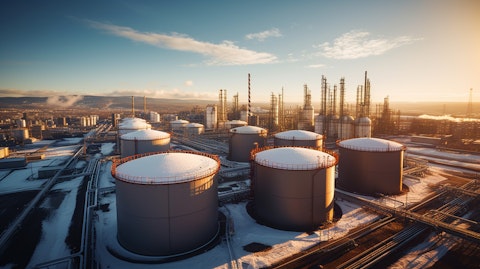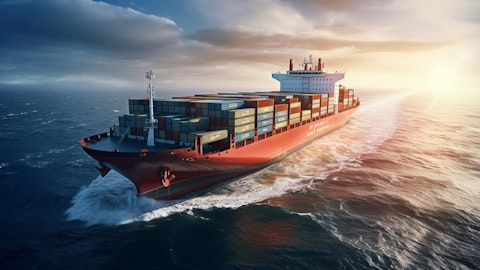DMC Global Inc. (NASDAQ:BOOM) Q3 2025 Earnings Call Transcript November 4, 2025
DMC Global Inc. misses on earnings expectations. Reported EPS is $-0.08 EPS, expectations were $0.01.
Operator: Greetings, and welcome to the DMC’s Global Third Quarter Earnings Call. [Operator Instructions]. As a reminder, this conference is being recorded. It is now my pleasure to introduce your host, Geoff High, VP of Investor Relations. Thank you, Geoff. You may begin.
Geoff High: Hello, and welcome to DMC’s third quarter conference call. Presenting today are President and CEO, Jim O’Leary; and Chief Financial Officer, Eric Walter. I’d like to remind everyone that matters discussed during this call may include forward-looking statements that are based on our estimates, projections and assumptions as of today’s date and are subject to risks and uncertainties that are disclosed in our filings with the SEC. Our business is subject to certain risks that could cause actual results to differ materially from those anticipated in our forward-looking statements. DMC assumes no obligation to update forward-looking statements that become untrue because of subsequent events. Today’s earnings release and a related presentation on our third quarter performance are available on the Investors page of our website located at dmcglobal.com.
A webcast replay of today’s presentation will be available at our website shortly after the conclusion of this call. And with that, I’ll now turn the call over to Jim O’Leary. Jim?
James O’Leary: Thank you, Geoff, and thank you to everyone joining us for today’s call. While challenging market conditions continue to impact each of DMC’s businesses during the third quarter, we made significant progress on the most important strategic objective within our control, the continued deleveraging of our balance sheet. By the end of the third quarter, our net debt had been reduced to $30.1 million, down 47% since the start of the year and the lowest level since we purchased the controlling interest in Arcadia at the end of 2021. DMC’s consolidated third quarter sales were $151.5 million, down 1% versus the third quarter a year ago, while adjusted EBITDA attributable to DMC was $8.6 million, up 51% year-over-year.
At Arcadia, our Building Products business, third quarter sales totaled $61.7 million, a 7% year-over-year increase, but down 1% from the second quarter. Adjusted EBITDA attributable to DMC more than doubled to $5.1 million from the year ago quarter, reflecting improved operating performance and better absorption of fixed manufacturing overhead due to the sales increase. Adjusted EBITDA was up 27% sequentially. The efforts to stabilize Arcadia’s business during the past year have helped mitigate the impact of stubbornly high interest rates and generally soft commercial construction activity in Arcadia’s core Western region, where architectural billings have declined every month since May according to the Architectural Billing Index. At DynaEnergetics, our Energy Products business, third quarter sales were $68.9 million, down 1% year-over-year and up 3% sequentially.
The third quarter was marked by declining activity in DynaEnergetics core U.S. onshore market, where well completions were down 8% year-over-year and 6% sequentially. At the end of the quarter, active frac crews, a key indicator of demand, were down nearly 20% from the 2025 peak in March. DynaEnergetics reported third quarter adjusted EBITDA of $4.9 million, up from breakeven in the year ago quarter, but down 46% sequentially. The sequential decline reflects lower product pricing and higher costs due to tariffs as well as certain receivable and inventory charges. At NobelClad, our composite metal business, third quarter sales were $20.9 million, down 16% year-over-year and down 21% sequentially. The declines reflect the delayed impact of lower U.S. bookings during the first and second quarters when customers move to the sidelines as they monitor fluctuating U.S. and reciprocal tariff policies.
Adjusted EBITDA was $2.1 million, down 64% from the prior year and 53% sequentially, reflecting lower absorption of fixed manufacturing overhead on reduced sales and a less favorable product mix. During the third quarter, NobelClad booked a $20 million order associated with a large international petrochemical project. After quarter end, we received an additional $5 million order related to that same project. Together, these bookings, which ship at the beginning of next year, reflect the largest order in the 60-year history of NobelClad. NobelClad’s backlog at the end of the third quarter was $57 million, up 53% from the second quarter, not including the $5 million follow-on. I’ll now turn the call over to Eric for a closer look at our third quarter results and our outlook for the fourth quarter.

Eric Walter: Thank you, Jim. I’ll start off with a closer look at third quarter profitability. As Jim mentioned, consolidated adjusted EBITDA attributable to DMC was $8.6 million. Inclusive of the Arcadia noncontrolling interest, adjusted EBITDA was $12 million or 7.9% of sales, up from 4.6% in the third quarter last year and down from 10.4% in the second quarter. The year-over-year increase in EBITDA margin principally reflects improved results at DynaEnergetics, which was impacted by $5 million in inventory and bad debt charges in last year’s third quarter as well as price-driven top line growth at Arcadia, leading to improved absorption of fixed manufacturing overhead. The sequential decline in adjusted EBITDA margin was primarily due to lower pricing and higher costs at DynaEnergetics as well as reduced activity levels at NobelClad.
Arcadia’s third quarter adjusted EBITDA margin before noncontrolling interest allocation improved to 13.8% from 5.8% in the year ago quarter and 10.9% in the second quarter. Dyna’s adjusted EBITDA margin improved to 7.1% in the third quarter compared to less than 1% in last year’s third quarter. EBITDA margin was down from 13.4% in the second quarter for the reasons previously mentioned. NobelClad’s third quarter adjusted EBITDA margin was approximately 10% and was impacted by the tariff-related bookings slowdown earlier in the year. Adjusted EBITDA margin was down from 23.2% in the third quarter last year and 16.5% in the second quarter. Third quarter SG&A expense was $26 million or 17.1% of sales versus $28.2 million or 18.5% of sales in the third quarter last year.
Third quarter adjusted net loss attributable to DMC was $1.6 million, while adjusted loss per share attributable to DMC was $0.08. With respect to liquidity, we ended the third quarter with cash and cash equivalents of approximately $26.4 million. Total debt was $56.5 million, down 20% from the end of 2024. And as Jim mentioned, net debt was $30.1 million, down 47% from the end of last year. And now on to guidance. We expect fourth quarter sales to be in a range of $140 million to $150 million, while adjusted EBITDA attributable to DMC is expected in a range of $5 million to $8 million. Our guidance reflects the lag of converting recent record bookings at NobelClad into sales, which are expected in 2026. Our guidance range also anticipates continued headwinds in DynaEnergetics core North American market, which has been significantly impacted by both tariffs and declining well completion activity and may experience a seasonal slowdown late in the quarter as has been the case in recent years.
Although Arcadia is expected to experience a normal seasonal fourth quarter slowdown, it expects continued year-over-year improvement in profitability due to better operational execution. Our guidance is heavily influenced by macroeconomic concerns, volatility and visibility issues created by the current state of energy markets and tariff policies and is subject to change either upward or downward as market conditions evolve. With that, I’ll turn it back to Jim for some additional comments.
James O’Leary: Thanks, Eric. In an environment marked by volatile and declining energy prices, elevated interest rates and shifting tariff policies, we continue to focus on what’s in our control. DynaEnergetics is containing its costs while pursuing international opportunities and navigating an extremely challenging North American oil and gas market. As discussed and based on direct customer feedback, we expect the oilfield services market to face continued headwinds during the fourth quarter. Accordingly, we remain focused on the self-help measures within our control. As mentioned earlier, NobleClad secured a record order that its commercial team worked nearly 5 years to win while it rebuilds its order book and looks globally for new business opportunities.
And finally, at Arcadia, we’ve stabilized operations after a challenging 2024 and are positioning the business for an eventual recovery in its commercial and residential markets. Arcadia has now had several quarters of stability since we brought Jim Shladen back, and we believe we’ve successfully reset the business while we wait for market conditions to improve. Collectively, we’ve made substantial progress on our most important initiative, deleveraging our business. This remains our principal corporate objective as we work through generally challenging markets for each one of our operating companies. Our progress would not be possible without the hard work of our DMC associates, and I want to thank them for their continued contributions. And with that, we’re ready to take any questions.
Operator?
Operator: [Operator Instructions] Our first question comes from the line of Gerry Sweeney with ROTH Capital Partners.
Q&A Session
Follow Dmc Global Inc. (NASDAQ:BOOM)
Follow Dmc Global Inc. (NASDAQ:BOOM)
Receive real-time insider trading and news alerts
Gerard Sweeney: Start off with Arcadia. I know you — Jim, I know you mentioned the ABI was down, I think, out in the West, et cetera. But 2 questions on that front. One, are you seeing any green shoots? And then two, are there opportunities for additional operational improvements at Arcadia? Or is that level set for now?
James O’Leary: Okay. So we’re seeing green shoots, but remember, that’s very specific to us. We had, when I think the industry was still doing okay, and I would say just okay, both residential and commercial. We would turnover and some self-inflicted issues, we had a challenging 2 or 3 years after the acquisition. So a lot of our year-over-year improvement, our month-over-month improvement, a lot of the things we’re seeing are just introducing stability with Jim Bact, bringing back some employees who might have looked for green pastures, repairing some of the relationships that might have gotten a bit fray, both on the supplier side and the customer side. So we’re seeing some Arcadia-specific green shoots, but I wouldn’t read too much into that.
And from everything you can see, it’s observable and anecdotal, whether it’s our public peers, even one like JELD-WEN today, which is far more residential than us. But it’s a data point. If you subscribe to any of the credit agencies, you can see companies like Oldcastle and Pan Air. We’re all struggling with exactly the same issues, persistently high interest rates, overall cost and affordability, and that applies to commercial as well. And I think that’s starting to — that should start getting better, but I wouldn’t say you see the green shoots industry-wide. A Board of a company I’m on, I mean, we’re in every MSA in the country. If you put a gun to my head, I couldn’t tell you what MSA in the country is really doing well, maybe 1 or 2 in the Carolinas.
So all of our year-over-year improvement and green shoots that you categorize that, all very Arcadia specific and all because we brought back stability and some self-help measures. Now on what we can do specifically, stabilized things, brought back some key players, repaired relationships, really soft — the soft skills, which Jim is fantastic at. Jim would have a longer list of things that we can do next than I would. And a lot of it is we can still do better in terms of professionalization, maybe bringing some new skills in, maybe looking at — we’ve been underspending CapEx for a while on things that we’re going to have some decisions to make as to whether or not — where and when we want to put it in. There’s capital we might have put in, in 2021 that we’ve — we have to do, but whether or not you do it now, if you think you’re still going to be bouncing along the bottom is a really important question.
But we both have a very long list of things we can do that would be — and I wouldn’t say it’s — I would say it’s past self-help. It would be, okay, now we’re at the point where professionalization, bringing some new skills. We’re getting there now on the ERP implementation, some of the improvement to data quality for the first time in a while. So there’s a long list of things we work on, including on capacitization. The question is when is the right time? You don’t want to add it early if the market just doesn’t doesn’t fill up a paint line or fill up an anodizing line, right?
Gerard Sweeney: Yes. Understood. Yes. Got it. Switching gears, NobleClad large order. It sounded like it was going to ship in my words, first quarter, but I’m not sure how you exactly characterized it. But what would be the cadence of the shipping of that order? And over how many quarters, if more than one would this sort of take place?
James O’Leary: Yes. So I said 2026, but Eric will give you the particulars. It’s more back-end loaded than first quarter.
Eric Walter: I don’t have…
James O’Leary: I misspoke.
Eric Walter: No, I don’t have much to add to that other than, like Jim said, it will be second half of 2026 is where you’re going to see the bulk of the revenue from that order.
Gerard Sweeney: Got it. And just sticking with NobelClad, obviously, that’s a large international order. U.S. is facing some headwinds, but I think there’s a lot of opportunity in the Gulf at some point for some of this petrochemical stuff, but I’m just curious if you’re seeing any additional orders unlock? Or are they still tied up because of tariffs and other issues and just uncertainties?
James O’Leary: Well, we agree, and we hope you’re right about further petrochemical orders. But right now, if you asked the division President there, how he categorize the state of things, and we’ve went through his budget a couple of times in the last few months. If you have the choice of order or wait, people wait. And it’s — the tariffs were a big issue that impacted us early, particularly on 1 or 2 really big ones that we know we probably didn’t get because of tariffs. Right now, I think it’s just a general level of economic uncertainty. Outside of tech and a couple of really fare haired favored sectors, if you’re very capital intensive, if you’re very consumer-driven, if you’re very — in consumer, meaning the ultimate end markets, it can include automotives in there.
I mean nobody is rushing to do capital projects unless you’re bringing stuff back under some of the Trump policies, factory building, major CapEx, you’re going to wait before you order until you start to be a little bit more comfortable with the overall economy.
Operator: Our next question comes from the line of Katie Fleischer with KeyBanc Capital Markets.
Katie Fleischer: I wanted to dig into the tariff impacts in Dyna a little bit. How should we think about that impact in coming quarters? And is there any opportunity to push price within that market?
James O’Leary: Yes. So the impact to Dyna in the quarter was roughly $3 million. And to answer your question, to try to push price in the market, that’s extremely challenging right now. All of the players in the market are pretty much going through the same type of issues with importing steel and some other components that are used in their perforating systems. So what we’re doing right now is trying to figure out ways we can be more efficient with how we manufacture our products and being smart about the automation that we put into our manufacturing line. But to increase price is very difficult in the market right now.
Katie Fleischer: Yes, makes sense. Just any other details that you could give around the margin progression within Dyna and NobelClad for next quarter? Like does the midpoint of guidance assume that both of those are going to see a sequential decline?
James O’Leary: Well, I think for — just taking them one at a time. With Dyna, they’re going to continue to have the pressures that we talked about from a pricing standpoint. There may be some seasonal slowdown. And to the extent that there is, that puts additional pressure on margins because there’s less sales and less volume to absorb their fixed manufacturing overhead. And the same would be true of NobelClad. The large order that we talked about will ship in 2026. So we’re probably not going to get much of a benefit for the next good few quarters. And there, same thing. It’s going to be — to the extent that the sales are a little soft in the quarter, it’s going to put pressure on them because they’re not going to be able to absorb that overhead. So you can take that into your modeling, and it should show you that the margins will be pressured quarter-over-quarter.
Eric Walter: I’d add to that. I would add, if your assumption — whatever your assumptions are on end markets, will probably be right ahead, whether it’s lead by a couple of months, lead by a quarter, it will be right ahead of our margin progression because everything at NobelClad for the most part, has been absorption driven. A fair amount outside of the tariffs, which Eric just went through, there’s a little bit of mix, but it’s the pricing issue and the fact that the Permian is so challenging right now. When you think both of those end markets get better, you’ll see our margins pick up maybe disproportionately. I’d like to think we have some operating leverage, but it will be very end market dependent because I think we did the self-help things early, but you’re still — in NobelClad is the best example. You’re down $5 million of sales. That’s all throughput and that all comes through as overhead absorption.
Katie Fleischer: Got it. And then just one last question here. I know visibility is very limited. But just looking ahead, when you think about the recovery of these end markets, how much more downside is there from here? And what would you really need to see to give you some confidence that some of these demand trends are starting to pick up?
James O’Leary: Well, look, I mean, the first thing you need is stability. I am encouraged, and I would think the stability in the order book at NobelClad is a precursor. We won’t see that for a quarter or 2 or 2 or more as it’s mostly back-end weighted. But the fact that the order book picked up, we got a major biggest in our history order is a real positive. In the building industry, I think we have more self-help and more benefits just from being stable, but it’s still a really, really tough market. And the fact that the Fed has started cutting interest rates, some appropriate consternation as to whether or not the next move will be up or flat after Powell’s last couple of comments. You got a Fed that seems more favorably disposed, particularly with the recent appointees.
But it’s not clear that you’re going to see 3 or 4 cuts the way people might have been thinking a month or 2 ago or that will be dragged out over a longer period. And that is absolutely critical to get things going. I’d like to think we could see some green shoots sooner but I still think you got a grand total of 20 permits issued in some of the parts of Southern California that we’re most long-term excited for, but there’s just not a lot of activity. They’re continuing to keep a lid on permits. The activity is not there the way — honestly, the way some of these poor homeowners would like to see. But when that starts to loosen up, that will be a little bit divorced from interest rates. But building, if we get 2 or 3 cuts, building could start picking up in the back half of next year.
But I would say, if you listen to homebuilder calls, some of the larger distributors like Builders FirstSource, Beacon, anybody that’s out there, I wouldn’t say they’ve written off next year, but they’re very, very conservative about it because we’ve been burned a few too many times. So that’s — I think middle end of next year would be optimistic on housing, but I think we have some specific things that are Arcadia and Arcadia dependent. And honestly, the market I’m least knowledgeable about is obviously Dyna just from past history. But that’s the one where the volumes have held up, but a couple of industry prognosticators out there, they do comment on how consolidated our customers and our customers’ customers have gotten. We’re still at the point where we probably had the brunt of the tariffs that we’ve had to eat.
Once the markets take off and we get the opportunity to be selling the value that we bring, I think we’ll get some of the margin and price back, but that’s probably quarters away. But if you wake up and the Saudis decide they’re not going to keep the spigots open, that could change tomorrow.
Operator: Our next question comes from the line of Jawad Bhuiyan with Stifel.
Jawad Bhuiyan: I guess just based on what we’ve been hearing around a lot of these U.S. pressure pumping companies, it seems like activity levels are kind of bottoming and that’s kind of where we’re — I guess, the direction that we’re heading. And I guess more specifically, can you talk about or elaborate expectations for 2026, specifically within the perforating gun business and maybe also what current pricing looks like in that business? And then I just have a quick follow-up.
James O’Leary: Too early to talk about 2026. We’re one quarter at a time for good reason. The visibility is terrible. And we don’t comment on pricing other than if the market picks up and it’s a little less competitive, we should see some relief, but we’re nowhere near there right now.
Jawad Bhuiyan: Got it. And I guess just more specifically for oriented perforating guns. We’ve kind of heard that it’s been having a positive impact on production levels. I guess, could you maybe talk about what you’re seeing in the field?
James O’Leary: That’s true. We have a product. Yes, we have a product out there that’s self perforating gun as well. Yes. Technology is what’s driven a lot of the incredible production increases in the Permian for — in the last 10 years. We’ve been a leader there and continue to be.
Operator: There are no further questions at this time. I’d like to pass the call back over to James O’Leary for any closing remarks.
James O’Leary: We appreciate your patience. We are doing everything we can under the category of self-help and positioning ourselves for the eventual recovery. We didn’t get a chance to talk about except in the prepared remarks, but getting the balance sheet in shape, having your cost structure in shape, being ready for whether it’s opportunities or just the things we got to deal with next year and having a clean balance sheet, plenty of cash flow and a cost structure that will accommodate us are the things we’re working on. So we appreciate your patience. And for any employees listening, we appreciate your hard work and dedication. So thank you.
Operator: This concludes today’s teleconference. You may disconnect your lines at this time. Thank you for your participation.
Follow Dmc Global Inc. (NASDAQ:BOOM)
Follow Dmc Global Inc. (NASDAQ:BOOM)
Receive real-time insider trading and news alerts




